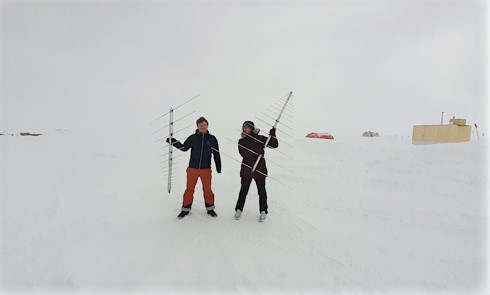Christoph Welling: neutrino researcher on a Greenland mission
Press & Communications
Christoph Welling: neutrino researcher on a Greenland mission

Greenland at last: Christoph Welling and Ilse Plaisier are installing the first antennas in the ice at Summit Station.
Christoph Welling currently is predominantly one thing: a quarantine professional. Before the astroparticle physicist from Zeuthen is allowed to set foot on Greenlandic ice for the first time, he needs a lot of patience. First, the pioneering project "Radio Neutrino Observatory Greenland" (RNO-G) was postponed for a year due to COVID, but with the approval for 2021 came the strict quarantine rules: first, two weeks of quarantine in Berlin, then the flight to Kangerlussuaq in West Greenland followed by another two weeks of isolation. "It's all going very slowly," says the 30-year-old. "But by now I have quarantine routine." He uses the time to work on his doctoral thesis. While sitting in his room at the National Science Foundation station, he writes the third paper.
Welling and his DESY colleague Ilse Plaisier are part of an international research team that is beginning to set up a unique facility in Greenland's glacial ice to search for fast particles from space. With the pioneering project "Radio Neutrino Observatory Greenland" (RNO-G), the astroparticle physicists are also testing a new measuring method: they want to see how well extremely energetic cosmic neutrinos can be detected with radio antennas. At the Summit Station research station, Welling and Plaisier, together with four other physicists and two borehole experts, are installing the first antennas in the ice.
A total of 35 stations with radio antennas are to be installed, each 1.25 kilometres apart, near Summit Station on the mighty Greenland ice sheet. Still, it can take months or even years for the detector to register something. "My work on site is to see if the technology, when it is set up, works and is able to detect the neutrinos," Welling says.
To his friends, the DESY scientist explains his work like this: "We plant radio antennas into the ice and see what happens." The researchers want to use the radio antennas to detect electrically charged particles that are created when a neutrino accidentally collides with an atom – such as in the Greenland ice sheet. The particles produced in this collision generate radio waves, which can be measured by the antennas.
"The advantage of radio waves is that ice is quite transparent to them," says Welling. "This means we can detect radio signals over distances of a few kilometres." The longer the range, the greater the volume in the ice that can be monitored, the greater the chance of detecting one of the rare neutrino collisions in the glacier. "RNO-G will be the first radio neutrino detector on a large scale," says Welling. Previously, smaller experiments had already shown that the detection of cosmic particles via radio waves is possible in principle.
A radio neutrino detector will later also be installed at the other end of the world in the IceCube-Gen2 neutrino observatory at the South Pole. "The two systems complement each other ideally," says Welling. "The optical IceCube detector will measure neutrinos up to an energy of about a quadrillion electronvolts, and the radio antenna array will be sensitive from about ten quadrillion to a hundred trillion electronvolts." The electron volt is a widely used unit of energy in particle physics. One hundred trillion electron volts is roughly equivalent to the energy of a squash ball hit hard at 130 kilometres per hour – but in the case of a neutrino, concentrated in a single subatomic particle that is trillions of trillions of times lighter than a squash ball.
Would IceCube perhaps also be a target for Welling one day? "Of course, if the opportunity comes up, I would love to go to Antarctica," he says. But for now he is looking forward to the next few weeks at the Summit Station full of anticipation and zest for action. "I'm really happy to be here. Everyone who works in the area has the dream of working on site one day." And for Welling it also means one thing at last: swapping the T-shirt and sweatpants of being a quarantined couch potato for the Extreme Cold Weather Gear with thick jacket, dungarees and ski goggles.